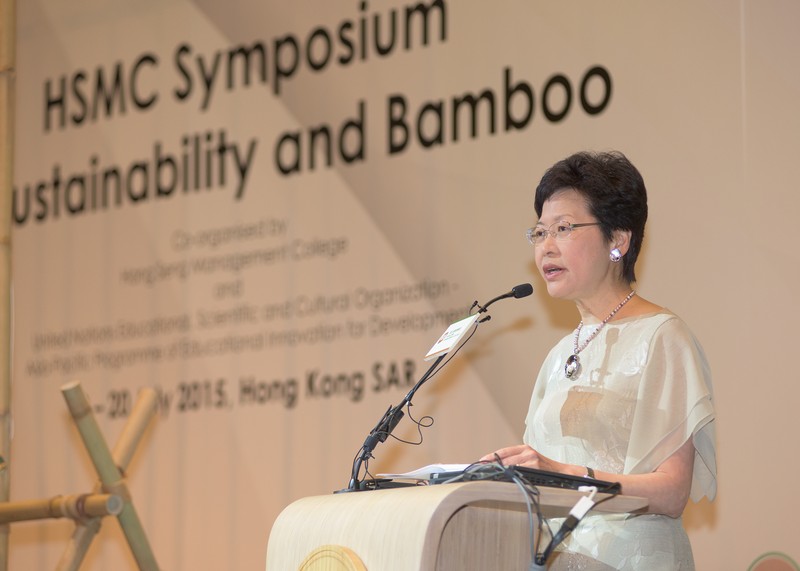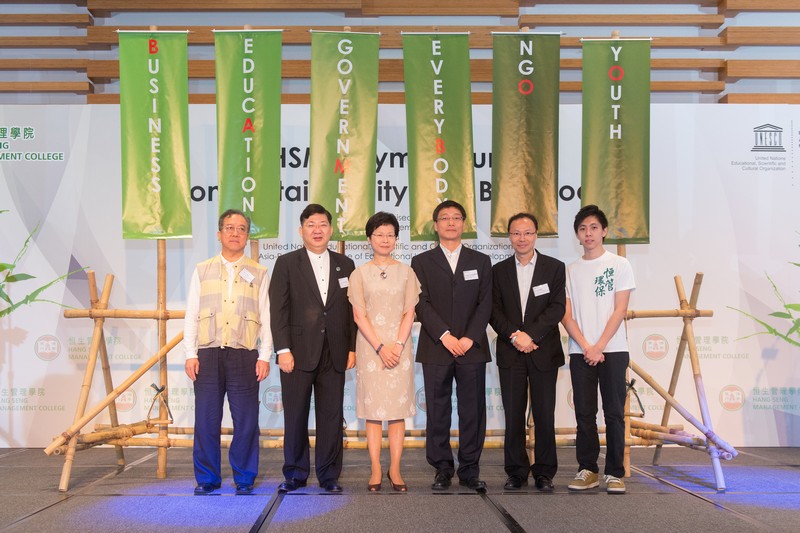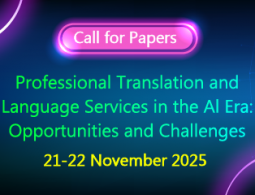2015年7月19日
Chief Secretary for Administration Gave HSMC her blessing on acquiring the university title at HSMC Symposium
Hang Seng Management College hosted the HSMC Symposium on Sustainability and Bamboo on 19 July 2015, and had the honour having The Hon Mrs Carrie Lam, GBS, JP, Chief Secretary for Administration of HKSAR Government to be one of our officiating guests.
In her speech, Mrs Lam recognised HSMC’s efforts to apply global green concepts to modernise the campus and to achieve Platinum accreditation for some of its buildings. She said, “My congratulations to the College, which over the years has evolved from a school of commerce to an excellent post-secondary college, awarding degrees and doing pioneering research. And personally, I am looking forward to the College becoming [re-titling as] a university in due course.” All the audience applauded to the encouraging blessing.
Mrs Lam acknowledged HSMC’s education philosophy which emphasises both liberal education and professionalism and the green-building applications in the College’s design. She remarked that the HKSAR Government shares the same goal in promoting green building through a three “Ps” approach: people, policy and partnership.
MrsCarrie Lam’s full speech:
Mrs Carrie Lam, GBS, JP, ChiefSecretary for Administration
Speech at the Opening Ceremony of Symposium (19 July) 9:30 am
Professor (Simon) Ho (President of HSMC), ProfessorWang (Li-bing) (Programme Co-ordinator, UNESCO – Asia-Pacific Programme ofEducational Innovation for Development), Dr (Tom) Fong (Chairman of SymposiumOrganising Committee), distinguished guests, ladies and gentlemen,
Good morning. I’m pleased to join you for theopening ceremony of this Symposium on Sustainability and Bamboo.
Bamboo is a deeply rooted aspect of Chinese cultureand features quite prominently in our daily lives. The bamboo, along with theplum blossom, the orchid and the chrysanthemum, are known as the Four Gentlemen,depicted for centuries through Chinese paintings and jade carvings for theirbeauty and character.
In particular, bamboo is celebrated for itsresilience and perseverance. Bruce Lee, the Kung Fu master, once said that,”The stiffest tree is most easily cracked, while the bamboo survives bybending with the wind.” We have long associated bamboo with strength ofcharacter, with integrity, elegance and surpassing flexibility.
All good reasons for Hang Seng Management Collegeto turn to bamboo as its theme for HSMC International Sustainability Week, onits 35th anniversary.
My congratulations to the College, which over theyears has evolved from a school of commerce to an excellent post-secondarycollege, awarding degrees and doing pioneering research. And personally, I amlooking forward to the College becoming [re-titling as] a university in due course.
My thanks, as well, to UNESCO – Asia PacificProgramme of Educational Innovation for Development for spearheading thisimportant symposium in conjunction with the College. Over the years, UNESCO hasbeen giving Hong Kong a lot of support especially in our heritage conservationwork. And for bringing in international experts to share the latest insightsinto the value of bamboo in the pursuit of sustainability.
Hang Seng Management College embracedsustainability from its very beginnings. Indeed, it has adopted an educationphilosophy which emphasises both liberal education and professionalism. Itscampus setting aims to encourage independent thinking, cultivate innovative minds,and nurture a caring spirit among its student body, bearing socialresponsibilities. Such a mindset is reflected in the College’s design, whichfeatures green-building applications from the use of natural light to thechilled ceiling air-conditioning system, solar reflection devices and otherelements. These have resulted in a reduction of electricity consumption in theSH Ho Academic Building by some 30 per cent.
In particular, the chilled-ceiling system makes useof ceiling-based radiant cooling panels coupled with chilled-water coils. Thisenhances thermal comfort by making use of convection and radiation.
Bamboo is also widely used in the campus, from itsgreen roof to its bamboo furniture and other interior design features.
I’m pleased to say that these environmental effortshave not gone unnoticed. The SH Ho Academic Building has achieved a BEAM PlusPlatinum Rating, making the College among the first higher-educationalinstitutions in Hong Kong to be so recognised.
Sustainable development, according to the WorldCommission on Environment and Development, “Meets the needs of the presentwithout compromising the ability of future generations to meet their ownneeds.”
In Hong Kong, we share with you the goal ofpromoting green buildings while, at the community level, we are pursuing asustainable built environment. We are doing so through a three “Ps”approach: people, policy and partnership.
The first “P” is “people”. Informulating public policy, our goal is to serve the people of Hong Kong, tosafeguard their interests. The same people-oriented approach is among the firstconsideration in a sustainable built environment, which aims to facilitateenjoyable living and working in an environment which is clean, comfortable,safe, healthy, and keeps people connected.
In his 2015 Policy Address, our Chief Executiveannounced the “smart city” concept. A smart city caters to the needsof its people, with an emphasis on enhancing connectivity and walkability.
I am pleased to note that, with the Energizing KowloonEast initiative, the Hong Kong Special Administrative Region (SAR) Governmentwill apply a smart city approach in urban planning. Among other things, we willwork to improve pedestrian facilities and landscaping to enhance walkability,as well as review traffic signal time to improve traffic flow.
An incentive scheme has been included to encouragegreen-building features in private development, and a district cooling systemis in place to keep the indoor areas of buildings comfortable, while reducingelectricity consumption by one fifth.
Kowloon East aside, the smart city concept will beincorporated into the design of other areas, including the West KowloonCultural District now taking shape on 40 hectares of prime harbour-front land.
Buildings there will feature attractive shading, adistrict cooling system and solar-thermal water heating. A sustainabletransportation system, including excellent public transport connections,cycling paths and pedestrians walkways, will also be provided.
The second “P” is “policy”. TheHong Kong SAR Government is working to create policy that incorporates asustainable built environment. In Hong Kong, buildings consume 90 per cent ofour electricity. That’s why we are leading by example in pursuing greeninitiatives, starting with our own government buildings.
For new government buildings with a constructionfloor area above 5 000 square metres, we have imposed a requirement that theymust attain the second highest grade or above under the BEAM Plus, or otherinternationally recognised building environmental assessment.
We have also extended the maximum payback periodfor energy-efficiency measures in new government buildings from nine years to12 years. With a longer payback period, the costs of energy-efficient featureswill be spread out over a longer period. It means that more efficient features,including energy-management systems and energy-efficient lifts, will becomepractical.
The third P is “partnership”. Apart fromleading by example, we’ve also put in place incentives to encourage privatedevelopers to conduct green-building assessments. When considering grantinggross-floor area concessions, registration for BEAM Plus certification isrequired. We also require, by law, that commercial buildings achieve a certainlevel of electricity efficiency.
As a further step to achieving our own sustainablebuilt environment, I am pleased to tell you that, in 2017, Hong Kong will hostfor the first time the World Sustainable Built Environment Conference. I hadthe privilege of leading the Hong Kong delegation to attend this importantgathering of green building experts held in Melbourne and Helsinki in 2008 and2011 respectively in my former capacity as the Secretary for Development. And Iam extremely excited that this world conference will come to Hong Kong in 2017,when we will celebrate the 20th anniversary of the establishment of the HKSAR.The tentative theme will be “Transforming our Built Environment throughInnovation and Integration: Putting Ideas into Actions.”
We look forward to showcasing how we can achievelow-carbon living alongside high-density development. Hong Kong already boastsone of the most energy-efficient transportation systems in the world. Thechallenge now is to make our buildings and built environment greener and moresustainable. And on this, we have made some initial success with Hong Kong’sfirst Zero Carbon Building being honoured with the Energy Globe Award 2015,which is one of the world’s most prestigious environmental awards.
I am pleased to see that Hang Seng ManagementCollege has taken a lead in this area. And I am sure this symposium will offera profusion of innovative ideas, alongside the latest intelligence, on how bestHong Kong, and the Asian region as a whole, can move towards a greener,brighter, future for all of us.
I wish International Sustainability Week everysuccess, and all of you here the very best of business. Sustainable business,of course.
Thank you very much.





